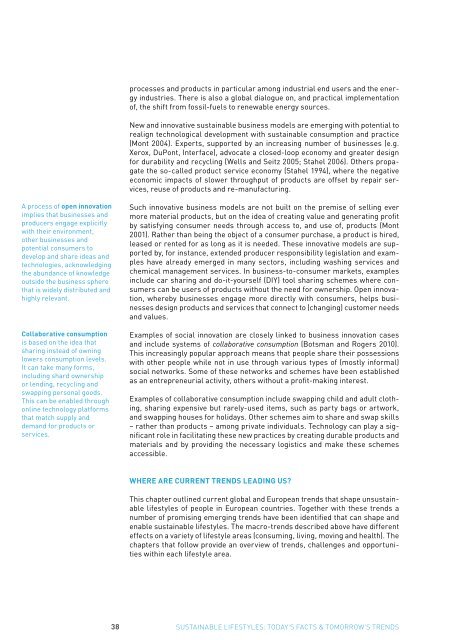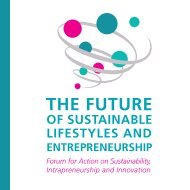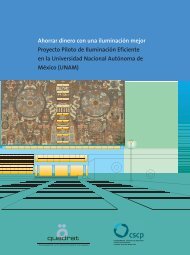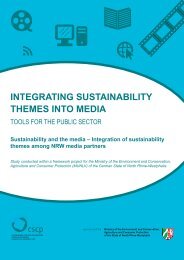today's facts & tomorrow's trends - SPREAD Sustainable Lifestyles ...
today's facts & tomorrow's trends - SPREAD Sustainable Lifestyles ...
today's facts & tomorrow's trends - SPREAD Sustainable Lifestyles ...
You also want an ePaper? Increase the reach of your titles
YUMPU automatically turns print PDFs into web optimized ePapers that Google loves.
processes and products in particular among industrial end users and the energy<br />
industries. There is also a global dialogue on, and practical implementation<br />
of, the shift from fossil-fuels to renewable energy sources.<br />
New and innovative sustainable business models are emerging with potential to<br />
realign technological development with sustainable consumption and practice<br />
(Mont 2004). Experts, supported by an increasing number of businesses (e.g.<br />
Xerox, DuPont, Interface), advocate a closed-loop economy and greater design<br />
for durability and recycling (Wells and Seitz 2005; Stahel 2006). Others propagate<br />
the so-called product service economy (Stahel 1994), where the negative<br />
economic impacts of slower throughput of products are offset by repair services,<br />
reuse of products and re-manufacturing.<br />
A process of open innovation<br />
implies that businesses and<br />
producers engage explicitly<br />
with their environment,<br />
other businesses and<br />
potential consumers to<br />
develop and share ideas and<br />
technologies, acknowledging<br />
the abundance of knowledge<br />
outside the business sphere<br />
that is widely distributed and<br />
highly relevant.<br />
Collaborative consumption<br />
is based on the idea that<br />
sharing instead of owning<br />
lowers consumption levels.<br />
It can take many forms,<br />
including shard ownership<br />
or lending, recycling and<br />
swapping personal goods.<br />
This can be enabled through<br />
online technology platforms<br />
that match supply and<br />
demand for products or<br />
services.<br />
Such innovative business models are not built on the premise of selling ever<br />
more material products, but on the idea of creating value and generating profit<br />
by satisfying consumer needs through access to, and use of, products (Mont<br />
2001). Rather than being the object of a consumer purchase, a product is hired,<br />
leased or rented for as long as it is needed. These innovative models are supported<br />
by, for instance, extended producer responsibility legislation and examples<br />
have already emerged in many sectors, including washing services and<br />
chemical management services. In business-to-consumer markets, examples<br />
include car sharing and do-it-yourself (DIY) tool sharing schemes where consumers<br />
can be users of products without the need for ownership. Open innovation,<br />
whereby businesses engage more directly with consumers, helps businesses<br />
design products and services that connect to (changing) customer needs<br />
and values.<br />
Examples of social innovation are closely linked to business innovation cases<br />
and include systems of collaborative consumption (Botsman and Rogers 2010).<br />
This increasingly popular approach means that people share their possessions<br />
with other people while not in use through various types of (mostly informal)<br />
social networks. Some of these networks and schemes have been established<br />
as an entrepreneurial activity, others without a profit-making interest.<br />
Examples of collaborative consumption include swapping child and adult clothing,<br />
sharing expensive but rarely-used items, such as party bags or artwork,<br />
and swapping houses for holidays. Other schemes aim to share and swap skills<br />
– rather than products – among private individuals. Technology can play a significant<br />
role in facilitating these new practices by creating durable products and<br />
materials and by providing the necessary logistics and make these schemes<br />
accessible.<br />
Where are current <strong>trends</strong> leading us?<br />
This chapter outlined current global and European <strong>trends</strong> that shape unsustainable<br />
lifestyles of people in European countries. Together with these <strong>trends</strong> a<br />
number of promising emerging <strong>trends</strong> have been identified that can shape and<br />
enable sustainable lifestyles. The macro-<strong>trends</strong> described above have different<br />
effects on a variety of lifestyle areas (consuming, living, moving and health). The<br />
chapters that follow provide an overview of <strong>trends</strong>, challenges and opportunities<br />
within each lifestyle area.<br />
38<br />
SUSTAINABLE LIFESTYLES: TODAY’S FACTS & TOMORROW’S TRENDS
















